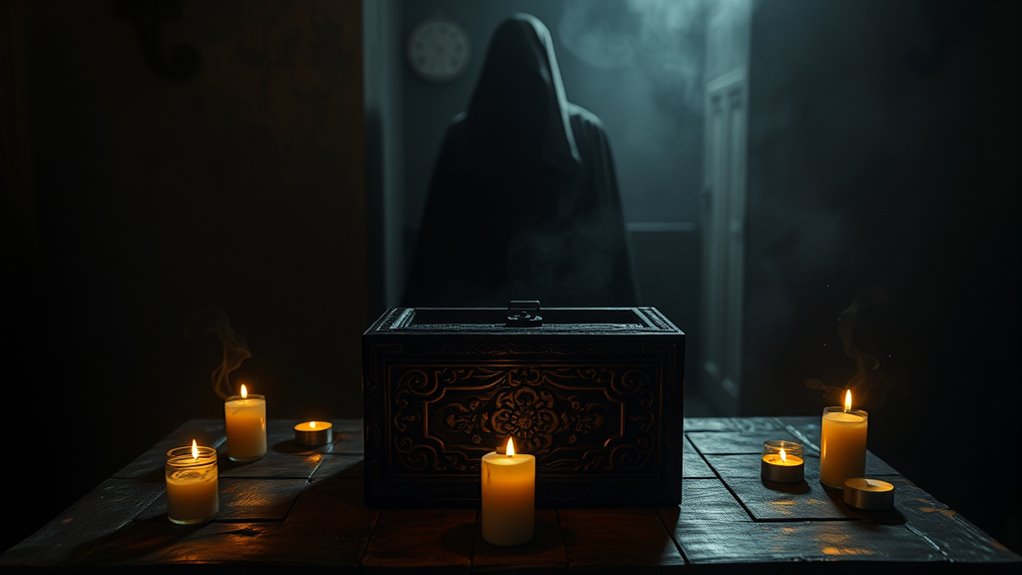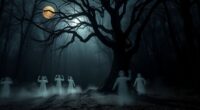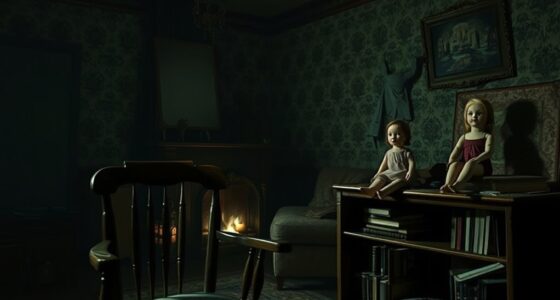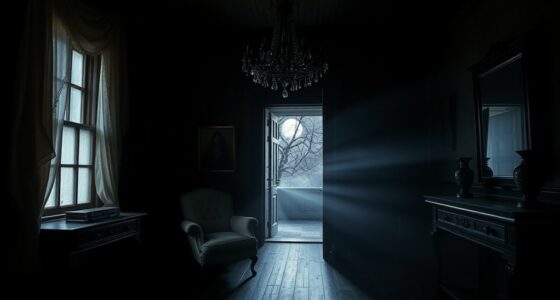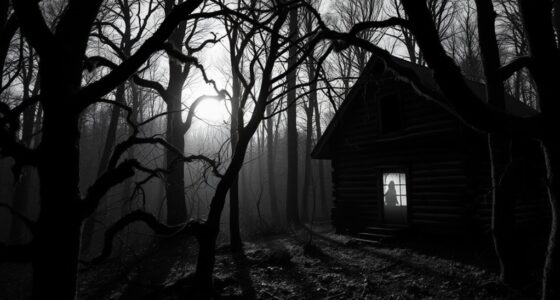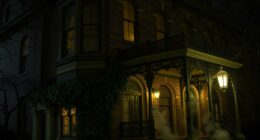The Dybbuk Box sparks debate on whether it’s cursed or just coincidence. Originating from Jewish folklore, the concept revolves around a restless spirit. Skeptics argue the box’s haunted history lacks evidence, with fabricated stories fueling its legend. Owners report strange phenomena like nightmares and unexplained illnesses. While emotional and psychological factors play a role, the media sensationalizes its story for profit. Want to uncover more about the box and its gripping background?
Key Takeaways
- The Dybbuk Box legend is rooted in Jewish folklore, where dybbuks traditionally inhabit living bodies rather than inanimate objects.
- Skeptics argue the box’s curse lacks historical basis and was fabricated by its owner to increase sales.
- Owners report vivid nightmares and physical ailments, suggesting a psychological impact rather than genuine paranormal activity.
- Media portrayals, particularly by shows like *Ghost Adventures*, often exaggerate supernatural claims, fueling public fascination with the box.
- Cultural narratives and emotional responses shape beliefs around the Dybbuk Box, blurring the line between superstition and coincidence.
Origins of the Dybbuk Box Legend

Origins of the Dybbuk Box Legend
Although the Dybbuk Box has gained notoriety in recent years, its roots lie deep in Jewish folklore, where the concept of a dybbuk—a restless spirit—originates. The term “dybbuk” comes from the Hebrew root “davek,” meaning to cling, symbolizing how these spirits attach themselves to the living. Art theory can provide insight into how cultural factors shape the interpretation of such legends. Additionally, these stories often reflect the emotional tributes and celebrations of the cultures that recount them. Individuals experiencing intense emotions may relate to the concept of a dybbuk, as many people have chronic feelings of emptiness that contribute to their struggles. Relationships, such as those faced by couples, can demonstrate both the challenges and joys of navigating shared experiences.
Historically, belief in dybbuks flourished in 16th and 17th century Eastern Europe, influenced by Jewish mysticism like Kabbalah. These malevolent spirits sought refuge in human bodies, enchanting the Jewish community with stories that inspired works like the 1914 play “The Dybbuk.” Additionally, exorcism practices were common, as individuals believed that miracle-working rabbis could expel dybbuks from those afflicted.
While tales of dybbuks focus on spirit possession, the idea of a dybbuk inhabiting an object, like the Dybbuk Box, marks a modern twist on this rich folklore.
Investigations and Skeptical Analysis
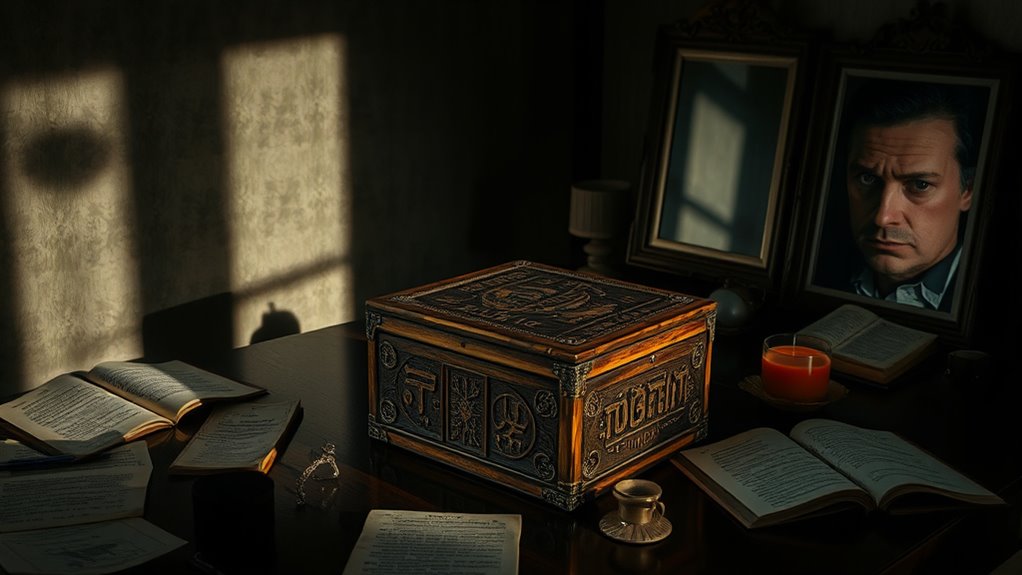
While many are captivated by the legend of the Dybbuk Box, investigations reveal a different story.
Skeptics like Brian Dunning and Kenny Biddle have shown that the box’s origin as a cursed item lacks historical basis. Biddle’s research found it’s not a Jewish wine cabinet from Spain but rather a minibar from New York. Additionally, the phenomenon of emotional availability often influences how people perceive and react to such stories, reflecting their personal experiences and relationships. Understanding the concept of credit score can illustrate how personal histories shape our perceptions of reality, similar to how individuals project their fears onto the Dybbuk Box. The emotional instability often associated with BPD may also contribute to how people interpret and engage with such folklore. Moreover, the impact of Natural Language Processing in enhancing customer interactions can parallel how individuals communicate their fears and beliefs about the box.
Furthermore, folklore suggests that dybbuks inhabit living bodies, not inanimate objects, which contradicts the box’s supernatural claims. The concept of emotional manipulation often seen in legends and myths may play a role in how such stories evolve over time.
Kevin Mannis, who fabricated the story to sell the item, later admitted to its fabrication.
The Dybbuk Box legend, fueled by media sensationalism and misinformation, has captivated many, but solid evidence points to it being a modern invention rather than a genuine haunted artifact.
Reported Paranormal Experiences
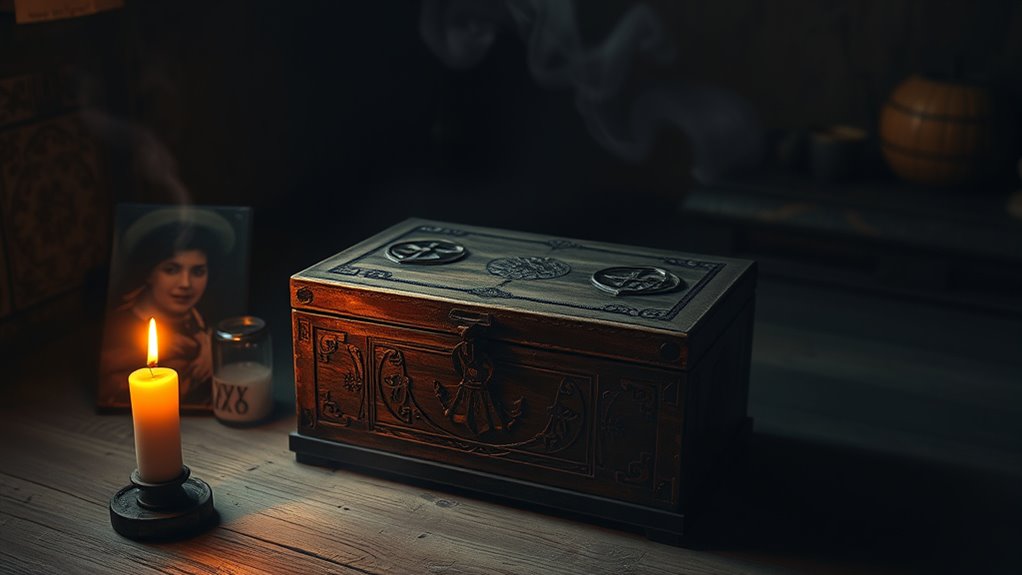
Many who’ve encountered the Dybbuk Box report chilling paranormal experiences that seem to defy explanation. You might find yourself plagued by vivid nightmares or suffer from unexplained illnesses like debilitating migraines. Some claim to wake up with bruises, while others experience severe hair loss or skin conditions. A constant feeling of unease can overwhelm you, leading to anxiety and paranoia. In fact, one owner, Haxton, experienced severe pain and night terrors after acquiring the box, which has been linked to a dybbuk spirit. Those affected often seek out routine health checks to address their physical ailments but find no clear medical cause. Furthermore, understanding aura variations can provide insights into the emotional and spiritual states that may be affected by such encounters. It is believed that these experiences may stem from a fear of intimacy and relationships. You may even see shadowy figures or hear disembodied whispers. The phenomenon surrounding the box illustrates the importance of user feedback in understanding and addressing unexplained experiences. Furthermore, reports suggest that the box may contain supernatural energy that amplifies these unsettling encounters. Electrical issues, like lights burning out, often occur in the box’s presence, along with sudden cold spots or unsettling atmospheres. Each encounter leaves a lasting impact, creating an environment where fear and fascination intertwine, making it hard to dismiss the box’s sinister reputation.
Media Influence and Cultural Impact
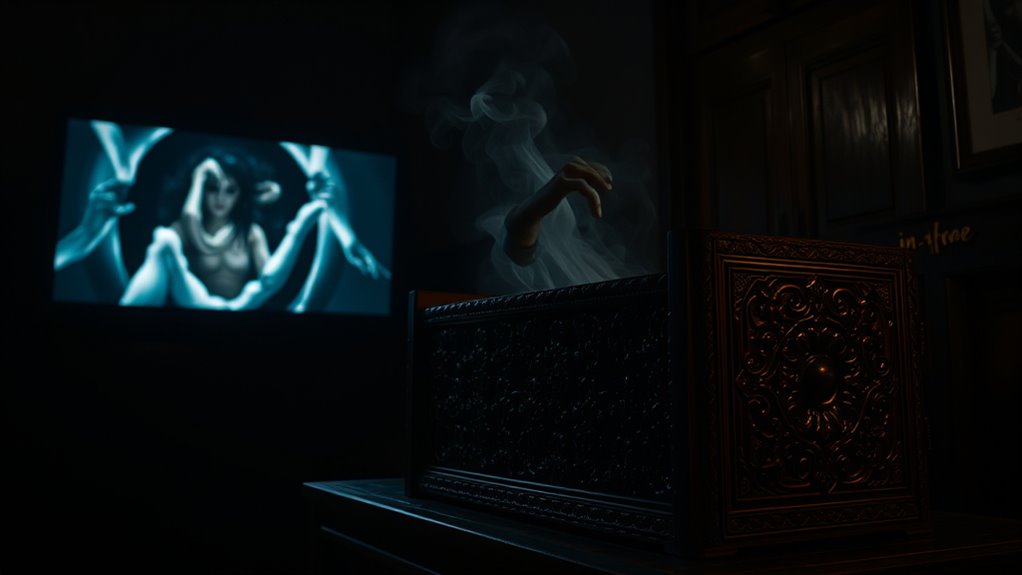
As the Dybbuk Box phenomenon spreads through social media and reality TV, its impact on popular culture becomes increasingly evident.
You’ll notice that platforms like TikTok and YouTube sensationalize this story, often misrepresenting Jewish folklore for entertainment. Shows like *Ghost Adventures* amplify its allure, blending horror with exaggerated claims of supernatural events. This phenomenon has been fueled by the involvement of Zak Bagans, who has tailored the narrative surrounding the box for commercial gain. The increasingly important role of community collaboration in artistic practices is often overlooked in the sensationalized portrayal of such cultural artifacts. Effective storytelling can lead to increased customer loyalty and advocacy, as audiences connect emotionally to the narratives presented. Additionally, the use of data analytics in marketing strategies can enhance the reach and engagement of such stories across social media platforms. Furthermore, utilizing predictive analytics allows marketers to tailor their approaches based on audience behavior, ensuring a more effective engagement strategy. The allure of adventure in discovery resonates with audiences, as they seek out new and thrilling experiences through these narratives.
Platforms like TikTok and YouTube distort Jewish folklore, while shows like *Ghost Adventures* heighten its eerie appeal with sensationalized supernatural claims.
This cultural trend reflects a modern thirst for sensationalism, overshadowing the deeper meanings behind Jewish mythology. You might find that this fascination has a global reach, inspiring art and literature while raising concerns among Jewish communities about cultural appropriation.
Ultimately, the media’s dramatized portrayal blurs the line between fact and fiction, influencing how you perceive this intriguing yet controversial phenomenon.
Skeptical Perspectives on Supernatural Claims
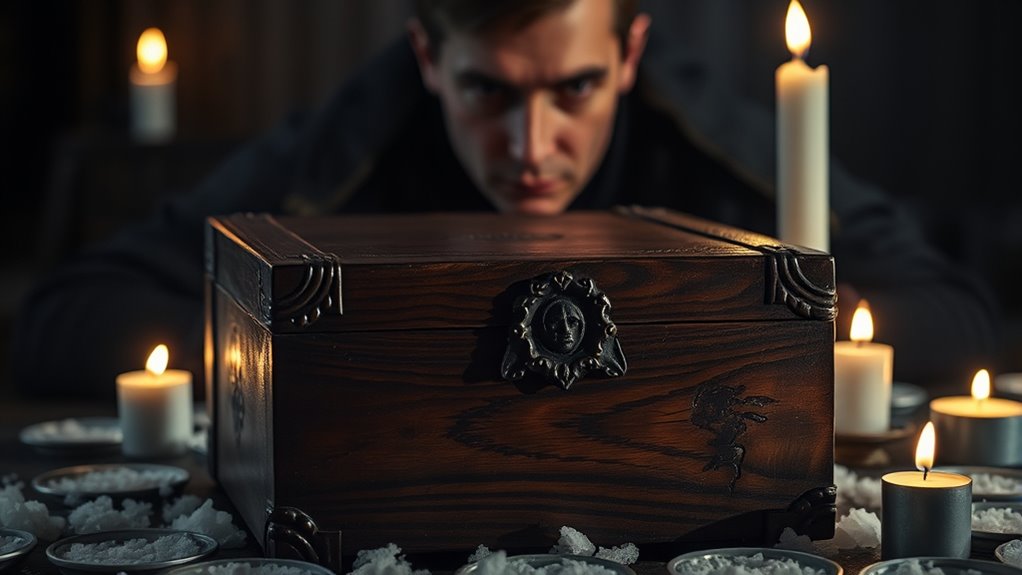
The fascination with the Dybbuk Box and similar supernatural claims invites a closer look at skepticism and how it shapes our understanding of such phenomena.
You’ll find that skepticism relies on rational inquiry and evidence-based reasoning to evaluate these claims. The principle of sufficient reason suggests that every phenomenon should have a positive explanation, dismissing unexplained mysteries as satisfactory answers. Many paranormal claims lack robust evidence, often misinterpreted through psychological effects or cultural narratives. Skeptics emphasize the scientific method, promoting critical thinking and an open-minded approach to evidence. Additionally, the Dybbuk Box’s historical journey, marked by varied experiences of its owners, raises questions about the authenticity of its curse. The reliance on robust contingency plans in addressing the unknown reflects a broader approach to uncertainty and risk management. Furthermore, holistic SEO practices can enhance the credibility of content surrounding such claims, as they prioritize user experience and content relevance. In navigating these complex narratives, it is important to consider the role of essential oil safety in promoting well-being and avoiding harm in holistic practices. Moreover, understanding the stages of emotional and psychological growth can provide insights into how individuals perceive and react to such supernatural claims. The phenomenon of urban legends often intertwines with these stories, illustrating how folklore shapes beliefs and fears within communities.
The Dybbuk in Cultural and Historical Context

While exploring the Dybbuk‘s significance, it’s essential to contemplate its rich cultural and historical roots within Jewish folklore.
Originating in the sixteenth century, the dybbuk embodies a restless spirit seeking refuge due to unresolved sins. Its earliest recorded exorcism took place in Basel in 1602, highlighting its deep spiritual connections. Exorcisms are conducted initially tied to Sephardic mysticism, it later integrated into Ashkenazi culture, reflecting communal struggles and spiritual crises.
The dybbuk also symbolizes unrequited love and unfinished business, famously depicted in Solomon Ansky’s play.
Frequently Asked Questions
Can I Buy or Own a Dybbuk Box?
You can buy or own a Dybbuk box, but you should think carefully before doing so.
Many claims about these boxes being haunted are likely fraudulent, and owning one might lead to anxiety or negative experiences due to superstition.
If you’re drawn to the folklore, remember that the reality often differs from the stories.
Consider the potential legal and ethical implications, too, as selling items with false claims can be problematic.
What Should I Do if I Feel Affected by a Dybbuk Box?
If you feel affected by a dybbuk box, it’s essential to distance yourself from it to ease any anxiety.
Consider talking to a mental health professional to help you process your feelings. Investigating the box’s history can also provide a rational perspective, helping you see it as folklore.
Engaging in stress-relief activities like meditation or exercise can further alleviate symptoms.
Are There Any Known Dybbuk Boxes in Museums?
Imagine wandering through a dark forest, where ancient spirits whisper their secrets.
You stumble upon museums housing Dybbuk boxes, like Zak Bagans’ Haunted Museum in Las Vegas. These artifacts, wrapped in folklore, are secured behind barriers, safeguarding you from their mysterious power.
Each box tells a story, warning visitors of the malevolent spirits they contain. If you’re curious, explore these tales, but tread lightly; the spirits may not welcome you.
How Can I Tell if a Box Is Truly a Dybbuk Box?
To tell if a box is truly a dybbuk box, start by examining its physical characteristics.
Look for an antique wine cabinet or a similar container, often linked to Jewish heritage. Investigate its provenance; stories of supernatural occurrences or curses should accompany it.
Check online forums and listings for claims related to the box.
Is There a Way to Cleanse or Protect Against a Dybbuk Box?
Imagine standing before an ancient box, its aura heavy with whispers of the past.
To cleanse or protect against such entities, you might employ exorcism techniques, invoking holy symbols like the *Magen David* to shield yourself.
Reciting protective prayers can create a barrier, while seeking guidance from spiritual advisors can offer deeper insights.
Proper disposal of the box is vital, too; it guarantees no lingering presence remains to haunt you.
Conclusion
As you close the lid on the Dybbuk Box legend, a chill runs down your spine, and shadows dance at the corners of your mind. You can’t help but wonder if it’s merely a tale spun from fear, or if something truly lingers within that weathered wood. The stories swirl around you like a fog, inviting you to question what’s real. In the end, you’re left with a haunting curiosity, forever drawn to the mysteries that lie beyond reason.
